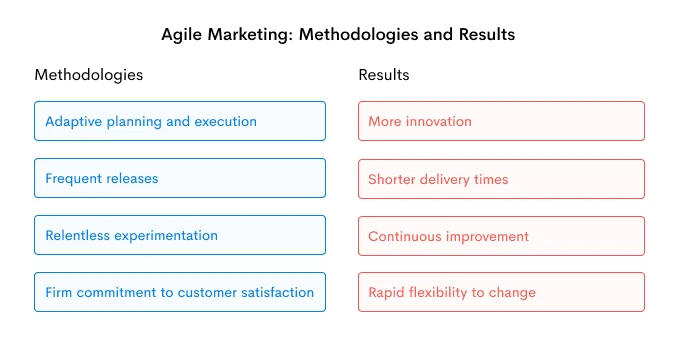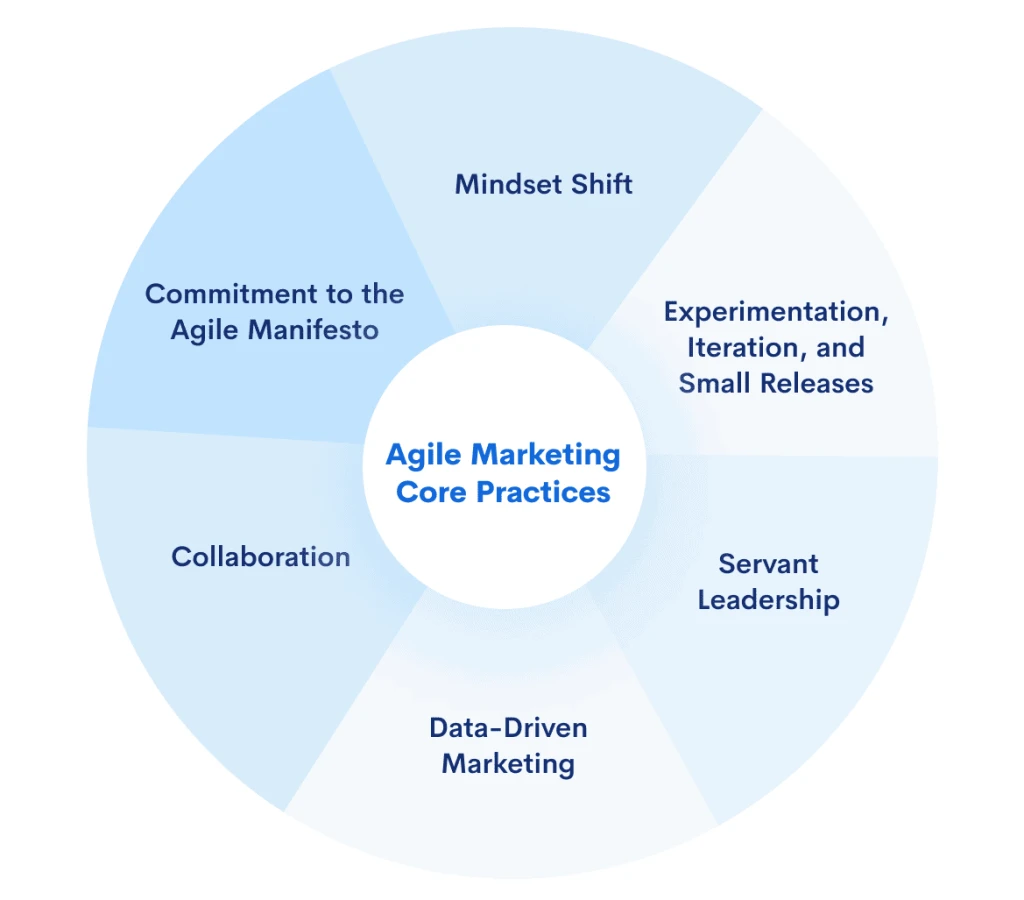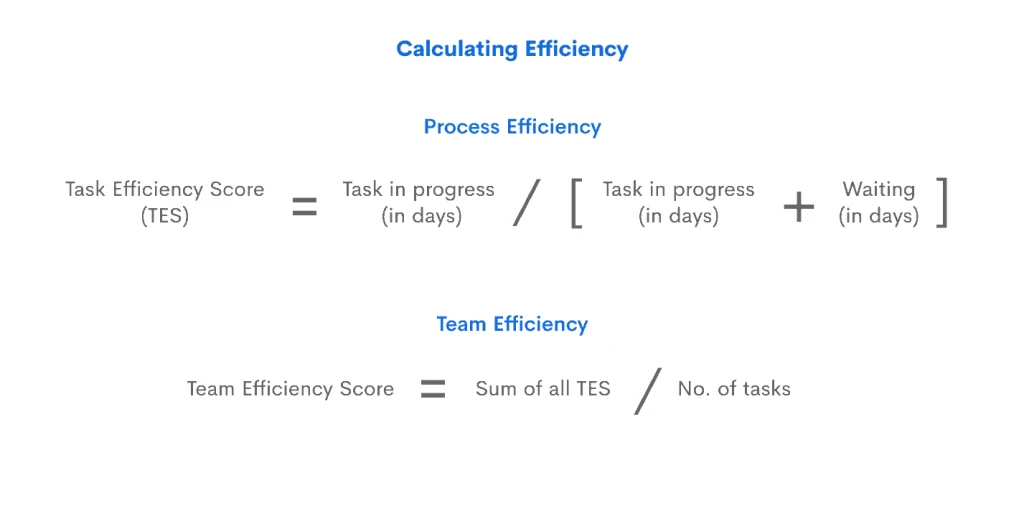We live in an age of exponential growth in the rate of technological advancement and ever-increasing customer expectations. In such an environment, marketing – like other business functions – cannot afford to do things the old way.
Yet, they do. Marketers continue to roll out large, infrequent campaigns and make media purchases that are organised the old way – by geography or product. All this points to a lag in the marketing environment. And agile marketing arose as a means to solve this lag, the result of which has been the inability of marketers to be effective in our quickly changing world.
What is agile marketing?
The crux of the matter
Agile marketing is, at its core, a way to improve how marketing is done.
It is an approach to marketing that is centred around the idea that business needs and solutions evolve through continuous collaboration between stakeholders.
It employs a set of unique methodologies to achieve a specific set of results, as detailed below.

A short note on the origins of agile marketing
A concept that has its origins in the software development world, Agile ways of managing knowledge work have transformed the way developers approach and do their work since the 1990s.
It arose in response to a need for software products that met not just product specifications but also customer needs. To achieve this, Agile replaced the top-down way of passing on information and managing projects which often became a case of Chinese whispers.
What does it look like in practice?
An Agile team is very distinct from its traditional counterpart. Here are the core practices of Agile teams that make them so.

Why go agile with your marketing team at all?
Agile is more than just a process change. It requires a shift in mindset from reactivity to being proactive, from dreading failures to celebrating and learning from them.
For this reason, when deliberating over whether to go the Agile way with your marketing team, sticking with business as usual may seem the easier option.
However, continuing the status quo will mean you stand to lose out on the myriad benefits that marketers across the board are experiencing after moving to Agile.
Consider the examples of Northern Arizona University and Dell.
Northern Arizona University
The small team of four marketers at Northern Arizona University followed traditional marketing practices earlier. But they soon found they couldn’t keep up with client expectations this way. Later, they phased out their reliance on contractors, instead handing out projects to team members based on their skills and availability. This elimination of externation dependencies and breaking down of the project into smaller chunks have meant that content production increased by 400%, cost savings have gone up by 20%, and sprint tasks saw a completion rate of 95%.
This case indicates that small teams can benefit immensely from agile marketing.
Dell
Dell’s 200-member-strong marketing team dealt with SEO, lead generation, channel marketing, field marketing, and more. The trouble was that the team worked differently across product lines and portfolios, leading to gaps and points of disconnection and processes that weren’t repeatable. To address these issues, Dell’s marketing team reorganised themselves into an agile formation and combined it with inbound marketing over seven months. The end result is a marketing team that operates far more better on one-month sprints now.
That size and complexity are no obstacles for agile is evident from this case.
Key benefits of embracing agile marketing
Flexibility and adaptability to new challenges
Two often confused terms, flexibility and adaptability are two key aspects of Agile marketing teams. While flexibility is defined as ‘the ability to be easily modified’, adaptability is ‘the ability to cope with unexpected disturbances in the environment.’
When applied to marketing, this means responsiveness based on data-backed insights which then allows teams to course-correct according to market feedback. This then drives efficiency and effectiveness.
From the field
Say a team has created some marketing content that it really believes in. However, they find that it is receiving no engagement from its target audience. In such a situation, an Agile team would quickly analyse the data to determine where the chinks are and re-iterate the content to suit market needs better.
Easier cross-functional collaboration
Agile marketing prioritises free-flowing collaboration. That is to say, on an Agile team, every member could be involved with any project. From social media marketers to data analysts, everyone should be able to collaborate with anyone else in the organisation. To enable this, initiatives such as cross-functional meetings and communication tools are often used.
From the field
Suppose a new member has joined the social media marketing team. Being new to the organisation, they have the opportunity to look into company products with fresh eyes and notice improvements that could be made to internal software systems. In an Agile marketing team, such suggestions would not only be welcomed but evaluated for merit and, if it has sufficient business impact, acted upon at the earliest.
Transparency that reduces project risk
Transparency allows the stakeholders of a project to see what actions have been taken towards achieving organisational goals.
A lack of transparency has an impact on the quality and value of work produced. This is because without transparency around processes and output, informed decisions cannot be made. And when the team is unable to make good decisions, they will not be able to deliver value and quality to their customers. With Agile marketing in place, you can reduce the risk of this happening.
From the field
Scrum boards – an Agile methodology – may be used to showcase what your marketing team is working on, facilitating clear visibility for anyone in the organisation who may be interested. Regular team meetings can also be held to assess the team’s progress towards goals.
Measurability of outcomes
Agile teams are constantly experimenting and measuring results to determine what to invest in so as to improve their campaigns most efficiently. With a clear focus on running tests and experiments to see what works, it is easy to see why measurability is central to Agile marketing when it comes to assessing success and failure.
Data and analytics is crucial to Agile marketing success. Without data-driven insights to measure success, organisations could be losing out on significant growth opportunities. According to a study by McKinsey, “81% of high-growth companies outperformed [their competitors] in data analytics” – a key piece of the Agile marketing puzzle.
From the field
Suppose a marketing campaign rolled out by an organisation was well-received by its target audience. Agile marketing teams, in such a scenario, would have a process in place for measuring campaign results using relevant metrics. They would put this to work as soon as possible to identify what exactly is working well about the campaign and look to replicate the success in other campaigns.
High morale and satisfaction
With more control over what they’re working on, Agile teams are more motivated, engaged, and satisfied than their counterparts in more traditional teams. To add to this, Agile methodologies also achieve the following, ultimately contributing further to employee morale and satisfaction levels. They:
-
make prioritisation easier,
-
empower all team members with information,
-
align expectations across the organisation, and
-
celebrate meeting commitments – big and small.
From the field
To ensure critical information around current projects is available to all team members, a short 10 to 15 minute stand-up meeting can be conducted each day in place of hour-long status update meetings through the week.
The requirement for the latter disappears in light of Agile methodologies because everyone already knows the status of projects, why a misstep took place, and the next steps to be taken.
Such an environment places the focus of meetings squarely on information dissemination and collaboration which then empowers team members to do their best work – no matter which project they’re working on – and enjoy high satisfaction levels.
Ensuring you’re getting results: key metrics
Efficiency
The most important measure of Agile marketing success, this metric can be used to measure the process efficiency of specific tasks or, more generally, the efficiency of the marketing team as a whole.
To measure the efficiency of your workflow, i.e., process efficiency, calculate the ratio between the time your tasks are being actively worked on and the time they spend waiting in queues.

Once you have the TES for individual tasks, your marketing team’s efficiency score can be calculated by averaging out your TES, i.e., the sum of all TES / no: of tasks.
Cycle time
Offering you a customer-centric view of your Agile marketing team’s performance, cycle time helps you answer the frequently asked question, “When will this task be completed?”

Comparing cycle time for tasks gives you an estimate of your team’s speed when dealing with a similar task type.
An increase in cycle time across processes indicates bottlenecks or other internal issues. One way to limit cycle time is to reduce the number of Work-in-Progress items.
Often, cycle times tend to dramatically lower in post-Agile teams as compared to pre-Agile teams.
Throughput
Throughput is a way to measure performance over time. It measures the number of tasks completed within a fixed time period and can be represented on a Kanban board as shown below. Here, the number of cards delivered per week is 10, 8, 12, and 10 over the course of 4 weeks.

Therefore, the throughput of the team can be said to be the average of these figures, i.e., 10.
Throughput is higher when the efficiency score is high and cycle time, low.
Summary
From increased speed to market and higher productivity to measurable outcomes and improved team morale, the advantages of going Agile with your marketing are many. To ensure you’re getting the best bang for your buck, keep tracking the key metrics of Agile and course-correct to get ever-better results over time.
